Content
- 1 Garden beds for cold and rainy regions
- 2 Harvest in the highest beds in cold and rainy climates
- 3 Cucumbers in tall beds in cold climates
- 4 Growing tomatoes in high beds in the cold and rainy climate of the Leningrad region
- 5 Growing peppers and eggplants in the Leningrad region
- 6 Growing melons in the Leningrad region in high beds. Grafted melons
- 7 Growing watermelons in the open field. Leningrad region
- 8 Garden beds for cold and rainy regions
- 9 Harvest in the highest beds in cold and rainy climates
- 10 Cucumbers in tall beds in cold climates
- 11 Growing tomatoes in high beds in the cold and rainy climate of the Leningrad region
- 12 Growing peppers and eggplants in the Leningrad region
- 13 Growing melons in the Leningrad region in high beds. Grafted melons
- 14 Growing watermelons in the open field. Leningrad region
- 15 Landing dates
- 16 Landing distance
- 17 Features of growing potatoes in the Leningrad region
- 18 Potato varieties for cultivation in the Leningrad region
High beds. Growing in the north of cucumbers, tomatoes, peppers, eggplant, watermelons, melons. Vaccinations of cucumbers and watermelons for lagenaria to increase yields. Grafted melons.
When laying a garden on a personal plot, most gardeners think about what vegetable and berry crops they would like to grow, many study information on varieties and agricultural technology. But most hardly think about what beds should be in their garden.
Speaking about the beds, I mean not only their length and width, but also about their height.
On the Internet, specialized magazines and books, you can find many ways to plant plants. But how to understand what exactly your garden needs?
First of all, I proceed from the climate and groundwater level.My vegetable garden is located in the north of the Leningrad Region, in a lowland, in a former swamp, with a high level of groundwater.
After reading various articles on growing vegetables on the Internet, as well as various specialized literature, I noticed a pattern - the warmer the region, the more people make the beds lower, or plant them on a flat surface, or make beds below the soil level, in "ditches".
In the south, it turns out, it is important not to warm up the soil, but rather to cool it. And in my northern region, the main factor of crop failures is the lack of heat. How to give the plants the warmth they lack?
Many gardeners know and apply in practice "warm ridges". Most often these are beds 30 cm high, under the bed, the earth was also removed on the bayonet of a shovel. Organic debris, grass, hay, manure are laid at the bottom, and the top is covered with a layer of 20 cm of earth. I also did so and planted thermophilic tomatoes, cucumbers and peppers. The plants liked it, the harvest, in comparison with previous years, pleased. But the next summer, in addition to the cool weather, we were flooded with rains. The harvest was bad. I tried to understand: what is wrong?
Garden beds for cold and rainy regions
I came to the conclusion that I need to give my plants as much heat as possible and protect them from the harmful effects of excess moisture... Low beds, with a large amount of precipitation and high groundwater, accumulate too much excess water, the processes of decomposition of organic residues slow down or stop altogether, plants do not receive heat, roots in cold, wet soil begin to die off. How to fix it? After all, you can't hide the whole garden under the roof?
The solution turned out to be quite simple - to increase the height of the beds. Now I have for ordinary crops (beets, onions, garlic, rutabagas, potatoes, strawberries) -beds 30 cm high, and under thermophilic (cucumbers, tomatoes, eggplants, peppers, zucchini) - beds 60cm high... And just under the cucumbers I in the spring I lay horse manure, make a "warm bed", you can read about it - HERE... For the rest of the crops, the warmth that tall beds accumulate in a day is enough.
Harvest in the highest beds in cold and rainy climates
Various vegetables and berries grow and develop beautifully on these beds.
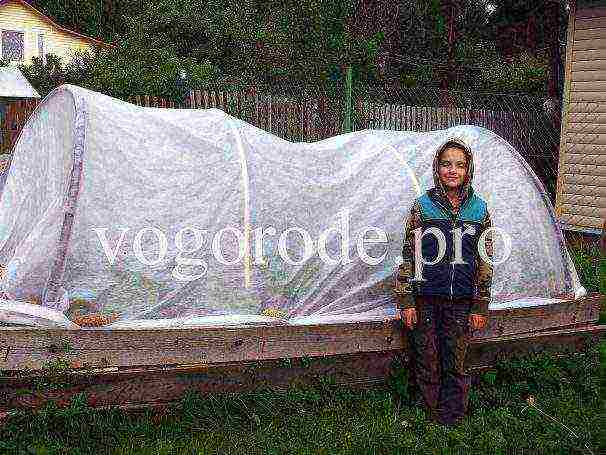 Beds for ordinary crops with a height of 30-45 cm
Beds for ordinary crops with a height of 30-45 cm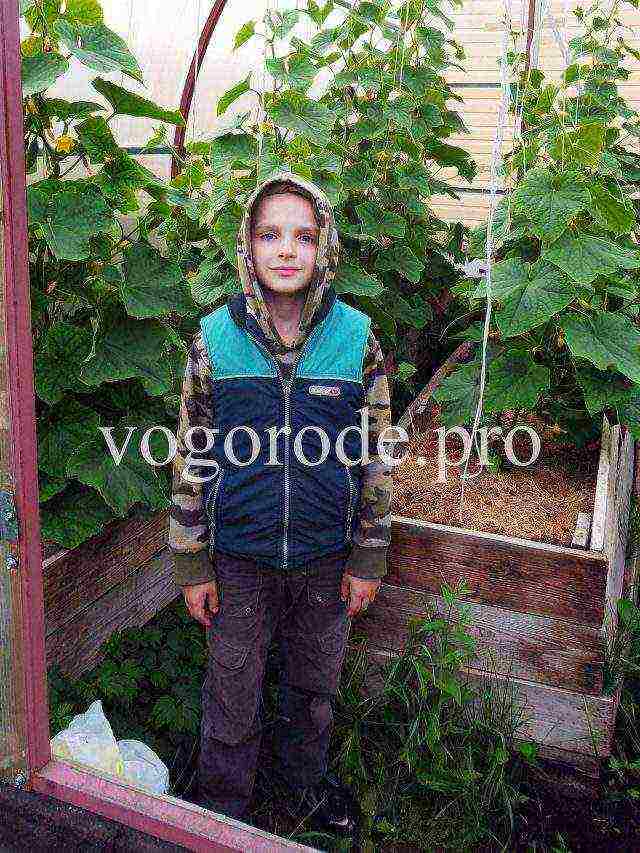 Beds in a greenhouse for thermophilic crops (cucumbers, tomatoes, eggplants, peppers) - 60 cm high.
Beds in a greenhouse for thermophilic crops (cucumbers, tomatoes, eggplants, peppers) - 60 cm high.
First of all, after moving to such high beds, I saw a significant increase in the yield of cucumbers and tomatoes in greenhouses. Cucumber plants grew faster and yielded more. Plants have ceased to suffer from such an unpleasant disease as root rot, which appears during rainy and cold weather. And most importantly, I was able to plant them much earlier and, accordingly, get an earlier harvest.
Cucumbers in tall beds in cold climates
For example, this year I took off the first cucumbers at the end of May, on average, depending on the weather, the first cucumbers appear in the first ten days of June without any additional effort on my part. Although earlier I had to install an additional film cover over the cucumber seedlings and additionally cover the ground with a film so that at night the soil does not give off heat so quickly. It was not difficult while I lived there from April to October, but when the children went to school, we only started coming in the spring for weekends. With such a shelter, in a "warm bed" filled with horse manure, on hot days, unattended, the planted plants could simply "burn out" and die.
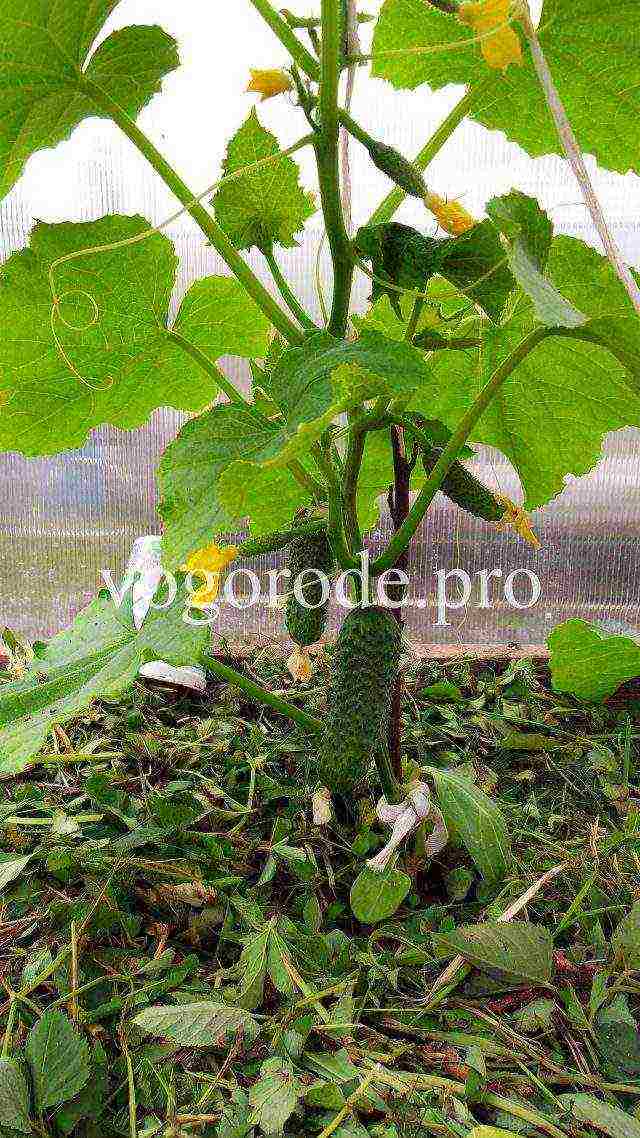 On May 29 it is very pleasant to eat your own cucumber grown in the Leningrad region.
On May 29 it is very pleasant to eat your own cucumber grown in the Leningrad region.
To increase cold resistance and increase yields, I additionally use this technique, as a grafting of cucumber plants on a stock - lagenaria. Grafted plants give their first harvest about 3 weeks earlier than unvaccinated ones, do not get sick and better tolerate night / day temperature drops that are typical for the Leningrad region and the northern regions. Lagenaria is resistant to cold snaps, low soil temperatures, its root system is much more powerful than cucumber.
"Vaccinations of cucumbers" - photos and videos, you can watch HERE.
In more detail, about the cultivation of grafted cucumbers, I will tell you - HERE
Growing tomatoes in high beds in the cold and rainy climate of the Leningrad region
As for tomatoes, the increase in yield was very encouraging, and most importantly, there are always a lot of them, regardless of the amount of rain. After all, everyone knows that the main enemy of tomatoes is moisture. Tomatoes do not tolerate excess moisture in the soil and air, they begin to hurt, incl. such a terrible disease as late blight, and the entire crop dies in the bud.
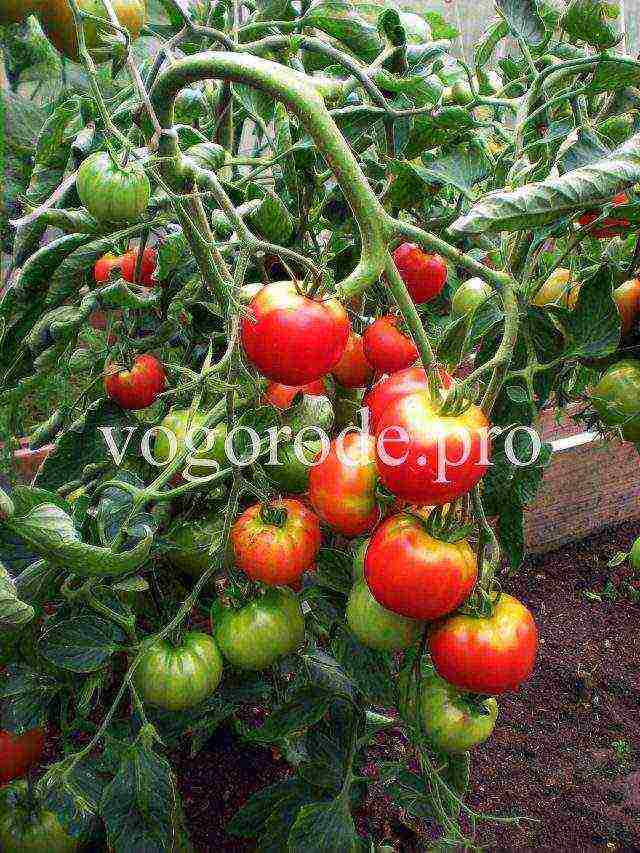 In such high beds in our cold climate, the number of ovaries on tomatoes has increased significantly
In such high beds in our cold climate, the number of ovaries on tomatoes has increased significantly
In addition to the increase in the number of tomato ovaries, their size has also increased.
 So, for example, tomatoes of the Pink Honey variety reach up to 700-900 g, and these are not single tomatoes, but most of the fruits from the bush.
So, for example, tomatoes of the Pink Honey variety reach up to 700-900 g, and these are not single tomatoes, but most of the fruits from the bush.
And most importantly, they always ripen! I do not remove green tomatoes and put them to ripening. My tomatoes are ripening on the bush! And when growing tomatoes I manage without such laborious work as creating a "warm bed". "Growing tomato seedlings in the Leningrad region" - HERE.
«Growing early tomatoes in a greenhouse in the Leningrad region. Harvest in June "- HERE.
Growing peppers and eggplants in the Leningrad region
Honestly, while I had low beds in the greenhouse, I practically did not plant eggplants and peppers. I tried it several times - the harvest was ridiculous to tears.Despite the fact that the seedlings need to be grown at home for several months, then transported to the dacha, a couple of eggplant fruits and a few peppers did not impress me. In eggplants and peppers, with a good development of the leaf mass, the flowers fell off all the time, in bad weather even the ovaries that began to grow could fall off.
When I made tall eggplant beds, the harvest impressed me so much that I realized that eggplant can be grown in the north!
Now it is enough for my family to plant only 4 eggplant bushes - it is enough for us to eat fresh, and to make preparations for the winter!
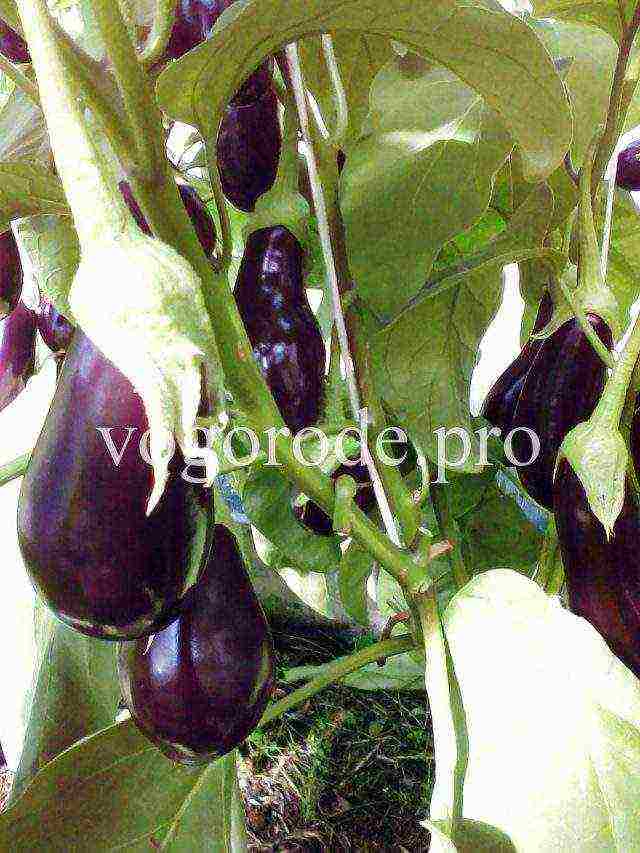 Eggplant harvest in a very high garden bed in the Leningrad region
Eggplant harvest in a very high garden bed in the Leningrad region
Besides cold, rainy weather, our region is famous for its white nights. And in all the literature on agricultural technology of eggplants it is written that they are short-day plants. Even having planted them on a high bed, I doubted whether they would grow? Shouldn't they also arrange a "warm bed" with horse manure? Shouldn't they be covered with a black cloth at night?
In 2012, I read the article “We grow eggplants ", and now, having very tall beds and forming plants - opening flowers to the sun, as advised in the article, I have excellent yields. I no longer have such problems as falling flowers and ovaries.
Growing eggplant seedlings. Care, formation, pinching of eggplants in the greenhouse of the Leningrad region - HERE
Growing melons in the Leningrad region in high beds. Grafted melons
After experimenting with cucumbers and tomatoes, peppers and eggplants, when I was confident that such beds would not let me down, I decided and planted melons and watermelons for a test.
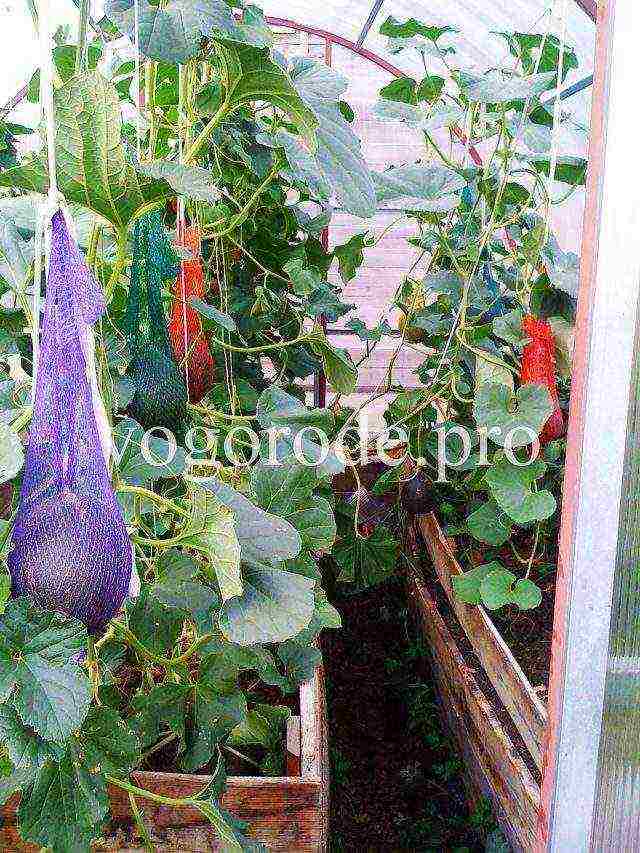 Melons grow in my greenhouse, in a vertical culture in the central garden, where the tomatoes grow.
Melons grow in my greenhouse, in a vertical culture in the central garden, where the tomatoes grow.
The requirements for air and soil moisture are similar.
In an ungrafted crop, the yield is about 5 melons weighing 1.5 kg per bush, in a grafted crop - 10 melons.
Melons, like cucumbers, can be grafted onto the stock, depriving them of their own, weak root system. Due to this, cold resistance is additionally increased, but the main thing is that the yield doubles! Melon care is quite simple, it does not like excess moisture, like a tomato, as well as excess organic matter in the soil, it needs more frequent watering only during the period of fruit growth. The most important thing at the initial stage is to correctly form the bush. About melon grafting... About the formation and care of melon bushes, I wrote in detail HERE
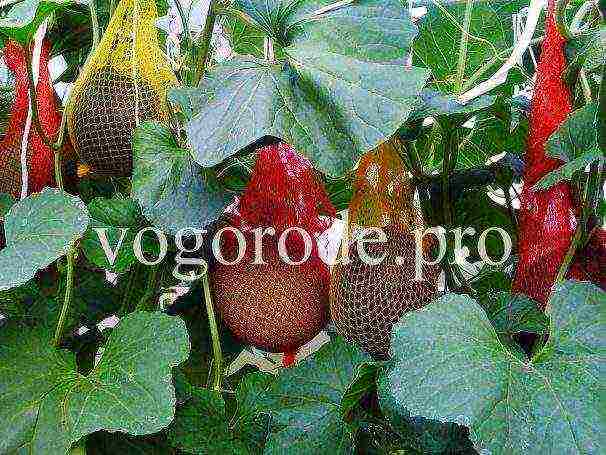 Melon harvest in a greenhouse, Leningrad region
Melon harvest in a greenhouse, Leningrad region
Growing watermelons in the open field. Leningrad region
Although I live in the north of the Leningrad Region, I grow watermelons in the open field.
For watermelons, a high bed with a height of 60 cm was made.
The soil is the earth with sand. Compost is applied only to the planting holes, no manure, because the fruits of watermelons, with a large amount of nitrogen in the soil, accumulate nitrates.
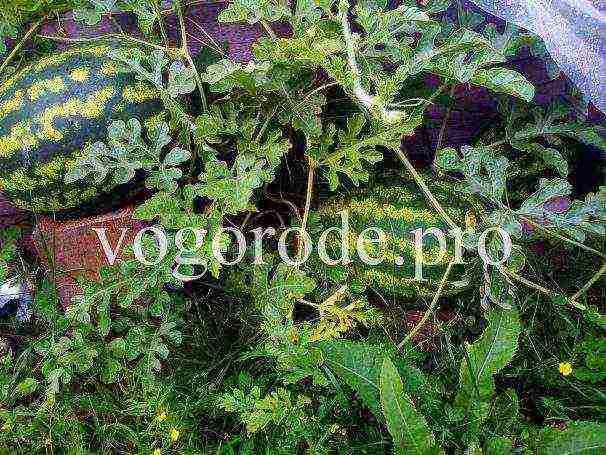 There, under arcs with non-woven material, the most delicious and sweet harvest grows - watermelons, grow up to 8 kg in weight, about 3-5 pieces per plant.
There, under arcs with non-woven material, the most delicious and sweet harvest grows - watermelons, grow up to 8 kg in weight, about 3-5 pieces per plant.
I also plant grafted watermelons. One of the reasons is that in a grafted culture, plants can be planted in the same bed from year to year, because the lagenaria used for rootstocks does not get sick with anything. The watermelons themselves are very prone to fusarium disease, and stable cold weather within one to two weeks after planting the plants is guaranteed to develop this disease on the plants.
I carry out vaccination and care for watermelons as in the article “Watermelons in the Moscow region ".
Perhaps you have a plot not in a swamp, not a peat bog, but sand, and there are no problems with the "flooding" of the plot during strong doges, but even in this case, in our northern, cold region, high beds will only increase your yield. After all, they will accumulate heat in themselves, like stoves, during the day, and give it to plants at night, because there are practically no warm nights in our region!
I will answer your questions in the comments.
St. Petersburg.
For the first time I will plant a garden with my own hands. House in the Leningrad region, there is no one to advise.Please, tell me some subtleties from your observations for a beginner in our climate. Where to look, everything is interesting. Thanks in advance.
I have long dreamed of planting a bole rose ... I would like to know which varieties winter better in St. Petersburg and the region?
Good afternoon, we are interested in the varieties of apple trees from the article about varieties for the northern garden of Gennady Raspopov - Borovichi. I have the opportunity to plant one apple tree, I need apples that will be stored as long as possible, preserving their taste….
Advise grape varieties for beginners ... The dacha is located in the Leningrad region, Luga district. I would like 3-4 varieties of different ripening times.
A question from our subscriber Svetlana: In the spring of 2015 we were on vacation in Hungary and brought from there the seeds of Paulownia (or Adam's tree). I planted them and over the summer they grew about a meter in height. Our dacha is located in Leningradskaya ...
I received apple, pear and cherry seedlings by mail. Can they be planted now in the Leningrad Region?
Do I need to cut the Heuchera in the fall in the Leningrad Region?
My new pet is grapes. This fall, my husband bought a Kosmos grape seedling. He was told that he was hardy, with good immunity. I found a place in the garden in a high bed, in the sun. I planted it, added it to the hole under the plant ...
Hello! I am a novice gardener. Can you tell me which varieties of tomatoes are better to plant in the north-west of the Leningrad region? Thanks.
Good people, tell me! I am going to order a pear from the nursery and am torn between the varieties “Prosto Maria” and “In memory of Yakovlev”. Two years ago, "Forest Beauty" and "Cathedral" were planted. There was also "Lada", but the mole devoured the roots in the very first summer and ...
A question from our subscriber Tatyana: I have a question about growing asparagus on a plot from seeds. When to plant seeds for seedlings in the Leningrad region? Is it worth messing around with seedlings or directly into the ground. Again, when? What sign of the zodiac does ...
Hello. Do you need water-charging watering for fruit trees, raspberries, currants, ezhemalin, gooseberries in the Leningrad region? Now, in the middle of October, is it too late yet?
I bought a weigela in March with leaves. When can you plant it in the garden? Leningrad region. Thanks.
A question from our subscriber Larisa: Dear experts, I have a summer cottage near Luga in the Leningrad Region and a few questions about growing purchased cereal seeds: triple-cut sedge, fine feather grass and “Maned” barley: - how ...
We grow grapes in the Leningrad region! There is an experience of growing in a greenhouse! I want to plant the Aleshenka variety without a greenhouse! The problem is high groundwater table! Shelter for the winter, so that it does not freeze or sniff! Thanks
Is it possible not to dig acidander for the winter in the climate of the Leningrad region?
December was warm ... New Year was celebrated at + 5 * C ... This is how the parks looked at the end of November. Occasionally, winter frightened us with a small snowball (already in December), which was smeared on the asphalt, trees and ground with a thin, thin layer))) But ...
Dear Semidachniki, my question is rather to the gardeners of the Leningrad region - are we taking seedlings to the dacha for May seedlings or is it too early? Last year, I took my plants away on April 23 and safely froze almost all the tomatoes ...
High beds. Growing in the north of cucumbers, tomatoes, peppers, eggplant, watermelons, melons. Vaccinations of cucumbers and watermelons for lagenaria to increase yields. Grafted melons.
When laying a garden on a personal plot, most gardeners think about what vegetable and berry crops they would like to grow, many study information on varieties and agricultural technology. But most hardly think about what beds should be in their garden.
Speaking about the beds, I mean not only their length and width, but also about their height.
On the Internet, specialized magazines and books, you can find many ways to plant plants. But how to understand what exactly your garden needs?
First of all, I proceed from the climate and groundwater level.My vegetable garden is located in the north of the Leningrad region, in a lowland, in a former swamp, with a high level of groundwater.
After reading various articles on growing vegetables on the Internet, as well as various specialized literature, I noticed a pattern - the warmer the region, the more people make the beds lower, or plant them on a flat surface, or make beds below the soil level, in "ditches".
In the south, it turns out, it is important not to warm up the soil, but rather to cool it. And in my northern region, the main factor of crop failures is the lack of heat. How to give the plants the warmth they lack?
Many gardeners know and apply in practice "warm ridges". Most often these are beds 30 cm high, under the bed, the earth was also removed on the bayonet of a shovel. Organic debris, grass, hay, manure were laid at the bottom and covered with a layer of 20 cm of earth on top. I also did so and planted thermophilic tomatoes, cucumbers and peppers. The plants liked it, the harvest, in comparison with previous years, pleased. But the next summer, in addition to the cool weather, we were flooded with rains. The harvest was bad. I tried to understand: what is wrong?
Garden beds for cold and rainy regions
I came to the conclusion that I need to give my plants as much heat as possible and protect them from the harmful effects of excess moisture... Low beds, with a large amount of precipitation and high groundwater, accumulate too much excess water, the decomposition of organic residues slows down or stops altogether, plants do not receive heat, roots in cold, wet soil begin to die off. How to fix it? After all, you can't hide the whole garden under the roof?
The solution turned out to be quite simple - to increase the height of the beds. Now I have for ordinary crops (beets, onions, garlic, rutabagas, potatoes, strawberries) -beds 30 cm high, and under thermophilic (cucumbers, tomatoes, eggplants, peppers, zucchini) - beds 60cm high... And just under the cucumbers I in the spring I lay horse manure, make a "warm bed", you can read about it - HERE... For the rest of the crops, the warmth that tall beds accumulate in a day is enough.
Harvest in the highest beds in cold and rainy climates
Various vegetables and berries grow and develop beautifully on these beds.
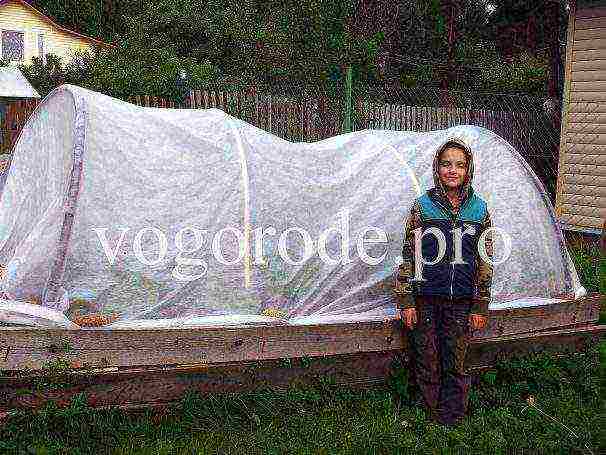 Beds for ordinary crops with a height of 30-45 cm
Beds for ordinary crops with a height of 30-45 cm Beds in a greenhouse, for thermophilic crops (cucumbers, tomatoes, eggplants, peppers) - 60 cm high.
Beds in a greenhouse, for thermophilic crops (cucumbers, tomatoes, eggplants, peppers) - 60 cm high.
First of all, after moving to such high beds, I saw a significant increase in the yield of cucumbers and tomatoes in greenhouses. Cucumber plants grew faster and yielded more. Plants have ceased to suffer from such an unpleasant disease as root rot, which appears during rainy and cold weather. And most importantly, I was able to plant them much earlier and, accordingly, get an earlier harvest.
Cucumbers in tall beds in cold climates
For example, this year I took off the first cucumbers at the end of May, on average, depending on the weather, the first cucumbers appear in the first ten days of June without any additional effort on my part. Although earlier I had to install an additional film cover over the cucumber seedlings and additionally cover the ground with a film so that at night the soil does not give off heat so quickly. It was not difficult while I lived there from April to October, but when the children went to school, we only started coming in the spring for weekends. With such a shelter, in a "warm bed" filled with horse manure, on hot days, unattended, the planted plants could simply "burn out" and die.
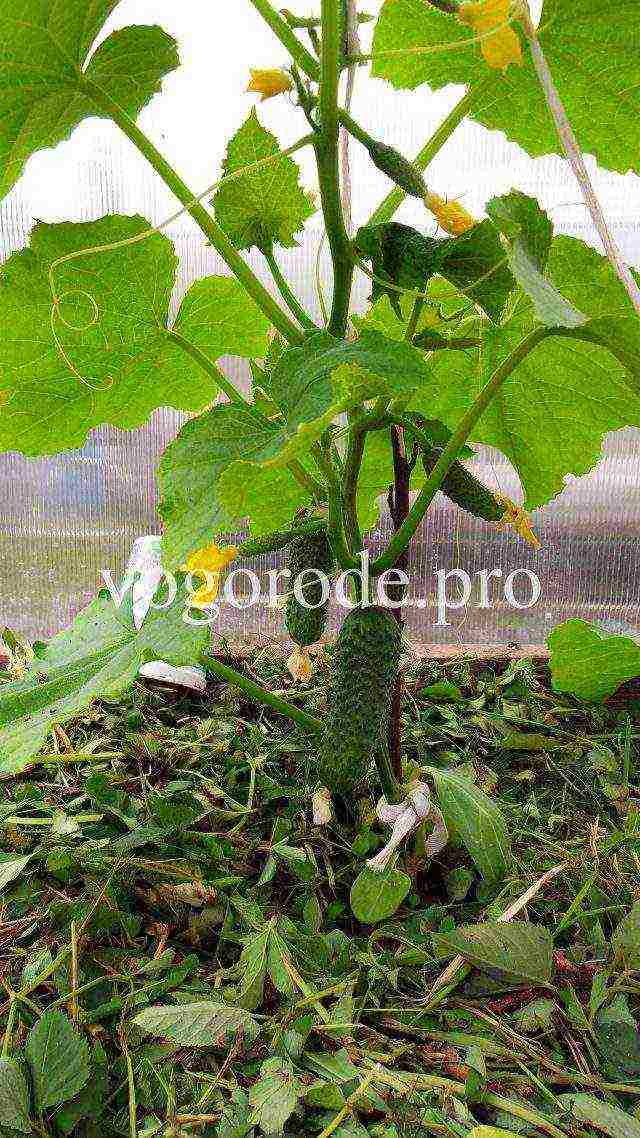 On May 29 it is very pleasant to eat your own cucumber grown in the Leningrad region.
On May 29 it is very pleasant to eat your own cucumber grown in the Leningrad region.
To increase cold resistance and increase yields, I additionally use this technique, as a grafting of cucumber plants on a stock - lagenaria. The grafted plants give the first harvest about 3 weeks earlier than the unvaccinated ones, do not get sick and better tolerate the changes in night / day temperatures, which are typical for the Leningrad region and the northern regions. Lagenaria is resistant to cold snaps, low soil temperatures, its root system is much more powerful than cucumber.
"Vaccinations of cucumbers" - photos and videos, you can watch HERE.
In more detail, about growing grafted cucumbers, I will tell you - HERE
Growing tomatoes in high beds in the cold and rainy climate of the Leningrad region
As for tomatoes, the increase in yield was very encouraging, and most importantly, there are always a lot of them, regardless of the amount of rain. After all, everyone knows that the main enemy of tomatoes is moisture. Tomatoes do not tolerate excess moisture in the soil and air, they begin to hurt, incl. such a terrible disease as late blight, and the entire crop perishes in the bud.
 In such high beds in our cold climate, the number of ovaries on tomatoes has increased significantly
In such high beds in our cold climate, the number of ovaries on tomatoes has increased significantly
In addition to the increase in the number of tomato ovaries, their size has also increased.
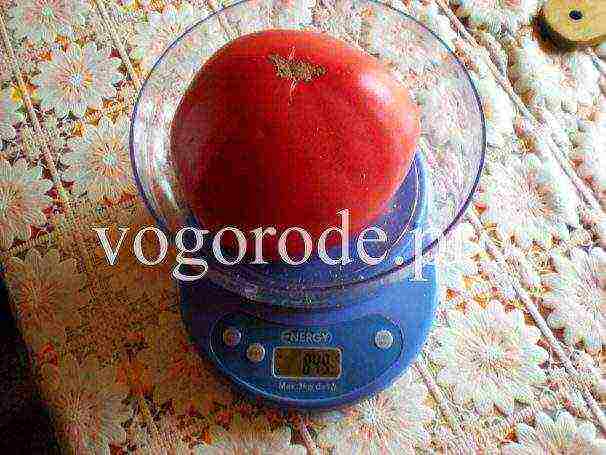 So, for example, tomatoes of the Pink Honey variety reach up to 700-900 g, and these are not single tomatoes, but most of the fruits from the bush.
So, for example, tomatoes of the Pink Honey variety reach up to 700-900 g, and these are not single tomatoes, but most of the fruits from the bush.
And most importantly, they always ripen! I do not remove green tomatoes and put them to ripening. My tomatoes are ripening on the bush! And when growing tomatoes I manage without such laborious work as creating a "warm bed". "Growing tomato seedlings in the Leningrad region" - HERE.
«Growing early tomatoes in a greenhouse in the Leningrad region. Harvest in June "- HERE.
Growing peppers and eggplants in the Leningrad region
Honestly, while I had low beds in the greenhouse, I practically did not plant eggplants and peppers. I tried it several times - the harvest was ridiculous to tears. Despite the fact that the seedlings need to be grown at home for several months, then transported to the dacha, a couple of eggplant fruits and a few peppers did not impress me. In eggplants and peppers, with a good development of the leaf mass, the flowers fell off all the time, in bad weather even the ovaries that began to grow could fall off.
When I made tall eggplant beds, the harvest impressed me so much that I realized that eggplant can be grown in the north!
Now it is enough for my family to plant only 4 eggplant bushes - it is enough for us to eat fresh, and to make preparations for the winter!
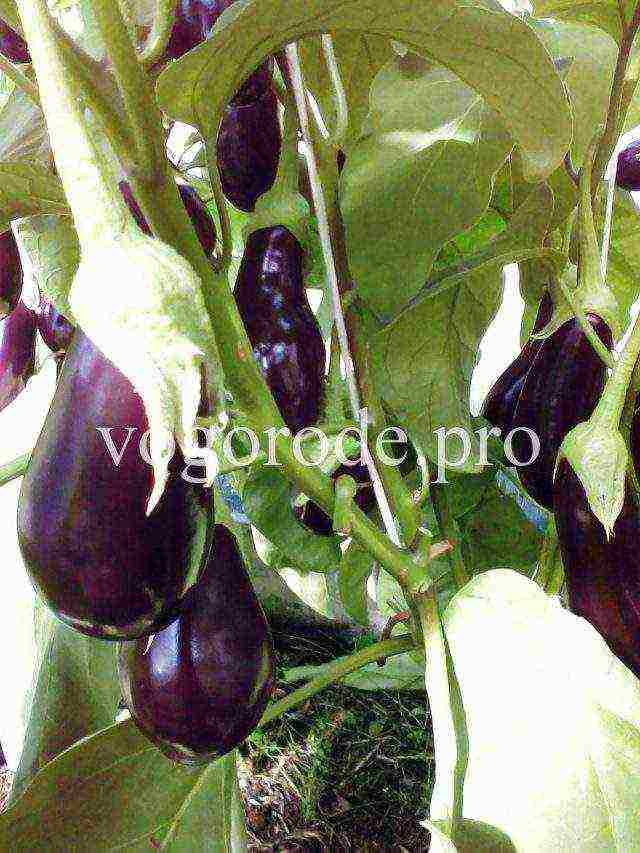 Eggplant harvest in a very high garden bed in the Leningrad region
Eggplant harvest in a very high garden bed in the Leningrad region
Besides cold, rainy weather, our region is famous for its white nights. And in all the literature on agricultural technology of eggplants it is written that they are short-day plants. Even having planted them on a high bed, I doubted whether they would grow? Shouldn't they also arrange a "warm bed" with horse manure? Shouldn't they be covered with a black cloth at night?
In 2012, I read the article “We grow eggplants ", and now, having very tall beds and forming plants - opening flowers to the sun, as advised in the article, I have excellent yields. I no longer have such problems as falling flowers and ovaries.
Growing eggplant seedlings. Care, formation, pinching of eggplants in the greenhouse of the Leningrad region - HERE
Growing melons in the Leningrad region in high beds. Grafted melons
After experimenting with cucumbers and tomatoes, peppers and eggplants, when I was confident that such beds would not let me down, I decided and planted melons and watermelons for a test.
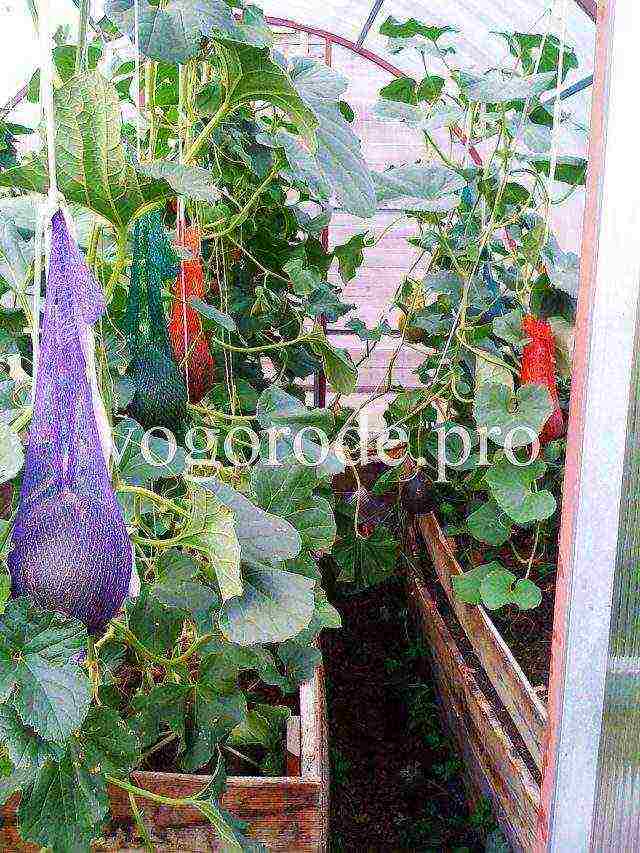 Melons grow in my greenhouse, in a vertical culture in the central garden, where the tomatoes grow.
Melons grow in my greenhouse, in a vertical culture in the central garden, where the tomatoes grow.
The requirements for air and soil moisture are similar.
In an ungrafted crop, the yield is about 5 melons weighing 1.5 kg per bush, in a grafted crop - 10 melons.
Melons, like cucumbers, can be grafted onto the stock, depriving them of their own, weak root system. Due to this, cold resistance is additionally increased, but the main thing is that the yield doubles! Melon care is quite simple, it does not like excess moisture, like a tomato, as well as excess organic matter in the soil, it needs more frequent watering only during the period of fruit growth.The most important thing at the initial stage is to correctly form the bush. About melon grafting... About the formation and care of melon bushes, I wrote in detail HERE
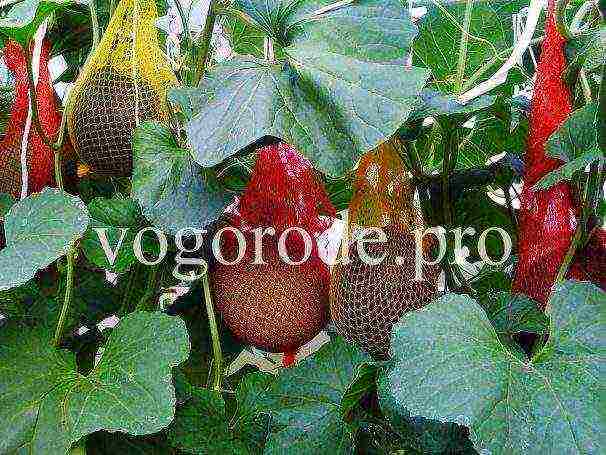 Melon harvest in a greenhouse, Leningrad region
Melon harvest in a greenhouse, Leningrad region
Growing watermelons in the open field. Leningrad region
Although I live in the north of the Leningrad Region, I grow watermelons in the open field.
For watermelons, a high bed with a height of 60 cm was made.
The soil is the earth with sand. Compost is applied only to the planting holes, no manure, because the fruits of watermelons, with a large amount of nitrogen in the soil, accumulate nitrates.
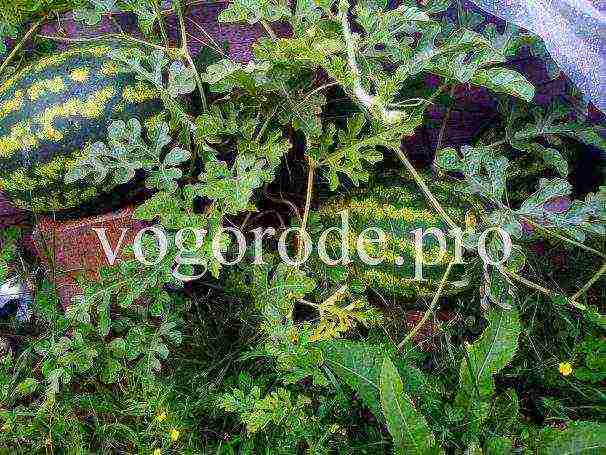 There, under arcs with non-woven material, the most delicious and sweetest harvest grows - watermelons, grow up to 8 kg in weight, about 3-5 pieces per plant.
There, under arcs with non-woven material, the most delicious and sweetest harvest grows - watermelons, grow up to 8 kg in weight, about 3-5 pieces per plant.
I also plant grafted watermelons. One of the reasons is that in a grafted culture, plants can be planted in the same bed from year to year, because the lagenaria used for rootstocks does not get sick with anything. The watermelons themselves are very prone to Fusarium disease, and stable cold weather within one to two weeks after planting the plants is guaranteed to develop this disease on the plants.
I carry out vaccination and care for watermelons as in the article “Watermelons in the Moscow region ".
Perhaps you have a plot not in a swamp, not a peat bog, but sand, and there are no problems with the "flooding" of the site during strong doges, but even in this case, in our northern, cold region, high beds will only increase your yield. After all, they will accumulate heat in themselves, like stoves, during the day, and give it to plants at night, because there are practically no warm nights in our region!
I will answer your questions in the comments.
St. Petersburg.
For the first time I will plant a garden with my own hands. House in the Leningrad region, there is no one to advise. Please, tell me some subtleties from your observations for a beginner in our climate. Where to look, everything is interesting. Thanks in advance.
Dear Semidachniki, my question is rather to the gardeners of the Leningrad region - are we taking seedlings to the dacha for May seedlings or is it too early? Last year, I took my plants away on April 23 and safely froze almost all the tomatoes ...
I have long dreamed of planting a bole rose ... I would like to know which varieties winter better in St. Petersburg and the region?
A question from our subscriber Svetlana: In the spring of 2015 we were on vacation in Hungary and brought from there the seeds of Paulownia (or Adam's tree). I planted them and over the summer they grew about a meter in height. Our dacha is located in Leningradskaya ...
Good afternoon, we are interested in the varieties of apple trees from the article about varieties for the northern garden of Gennady Raspopov - Borovichi. I have the opportunity to plant one apple tree, I need apples that will be stored as long as possible, preserving their taste….
My new pet is grapes. This fall, my husband bought a Kosmos grape seedling. He was told that he was hardy, with good immunity. I found a place in the garden in a high bed, in the sun. I planted it, added it to the hole under the plant ...
Advise grape varieties for beginners ... The dacha is located in the Leningrad region, Luga district. I would like 3-4 varieties of different ripening times.
Do I need to cut the Heuchera in the fall in the Leningrad Region?
Hello! I am a novice gardener. Can you tell me which varieties of tomatoes are better to plant in the north-west of the Leningrad region? Thanks.
A question from our subscriber Tatyana: I have a question about growing asparagus on a plot from seeds. When to plant seeds for seedlings in the Leningrad region? Is it worth messing around with seedlings or directly into the ground. Again, when? What sign of the zodiac does ...
We grow grapes in the Leningrad region! There is an experience of growing in a greenhouse! I want to plant the Aleshenka variety without a greenhouse! The problem is high groundwater table! Shelter for the winter, so that it does not freeze or sniff! Thanks
A question from our subscriber Larisa: Dear experts, I have a summer cottage near Luga in the Leningrad Region and a few questions about growing purchased cereal seeds: triple-cut sedge, fine feather grass and “Maned” barley: - how ...
I received apple, pear and cherry seedlings by mail. Can they be planted now in the Leningrad Region?
I bought a weigela in March with leaves. When can you plant it in the garden? Leningrad region. Thanks.
Hello. Do you need water-charging watering for fruit trees, raspberries, currants, ezhemalin, gooseberries in the Leningrad region? Now, in the middle of October, is it too late yet?
Is it possible not to dig acidander for the winter in the climate of the Leningrad region?
Good people, tell me! I am going to order a pear from the nursery and am torn between the varieties “Prosto Maria” and “In memory of Yakovlev”. Two years ago, "Forest Beauty" and "Cathedral" were planted. There was also "Lada", but the mole devoured the roots in the very first summer and ...
December was warm ... New Year was celebrated at + 5 * C ... This is how the parks looked at the end of November. Occasionally, winter frightened us with a small snowball (already in December), which was smeared on the asphalt, trees and ground with a thin, thin layer))) But ...
Summer is promised to be dry and hot. And you only appear at the dacha on weekends. But you still want fresh herbs, fruits and berries ... What now - to give up gardening? Not at all necessary!
It is clear that any plants, even weeds, require care - at least watering on hot days. But there are still unpretentious cultures that can do without your tender care for several days. So what to have time to plant now, so that the harvest in the fall will please? Our expert, agronomist Mikhail Vorobyov suggests.
1. Bushes and fruit trees.
Apple trees, plums, pears, bird cherry, currants, cherries, honeysuckle, irga, gooseberries, blackberries, raspberries, yoshta (a hybrid of gooseberries and black currants). In general, the choice is large. Even at a young age, when bushes and trees are just bought, they can survive if they are properly planted.
All shrubs and trees need an open, well-lit area. It is important for trees that in the future their roots are not accidentally broken when you dig up the ground for other plantings. Remember that the crown of apple, pear and other fruit trees can be up to three meters in diameter. This means that their roots will grow to the same size.
When planting, it is important to fertilize the soil well (as a rule, sellers warn what is required from fertilizers and at what depth to plant). Be sure to water it well, and then mulch the soil so that the moisture does not evaporate. Grass, bark, thin twigs of trees and bushes will help, which will tightly cover the soil.
Of course, in the first year you should not expect berries and fruits, but next year many shrubs will already begin to bloom and you will harvest the first harvest. In addition, the bushes will make a beautiful hedge for those who want not only a useful, but also a beautiful summer cottage.
2. Ground tomatoes.
As a rule, determinant and super-determinant varieties of tomatoes for soil planting were bred in arid regions of our country - Orenburg, Astrakhan regions. That is, they are genetically adapted to dryness and bright sun. And they will be able to withstand your long absence. These tomato bushes do not grow more than 1.5 meters, since growth stops almost immediately after the first ovaries. They also release deep roots and are able to get their own food and moisture, if they are not watered for several days. Usually, they don't even need to be tied up. But if there are a lot of brushes, then you will need to prop up the tomatoes.
The determinant varieties (that is, which ripen literally in 2-2.5 warm months) include "Dachnik", "Dubok", "Lights of Moscow" and others. True, they will need to cut off their stepsons. Superdeterminant varieties are able to give the first harvest in a month or a month and a half after planting. For example, this is "Son of a Hero", "Bonsai", "Beta". You can buy seedlings both in large hypermarkets and in the markets.There are still very undersized standard varieties that do not need to be tied up, or pinned, or tied up. These are Yabloko Rossii, Novichok, Raketa and others.
- You should not be afraid of the so-called fly-by-night firms that sell seedlings once a season, - says Mikhail Vorobyov. - This business is not at all profitable. Usually, large farms are engaged in seedlings, which make sure that the plants do not get sick, and that there are no pests. The only negative is that the seedlings are grown in greenhouses, that is, they are not hardened. Before planting tomatoes in the ground, I advise you to put the cups with seedlings in the shade, for example, in bushes. And let them stand there for a couple of days and nights, or at least one night. At least in the suburbs, the nights are now very warm and it doesn't hurt. But it will harden the seedlings a little. Then you can plant it in the ground.
Do not forget to cover the tender tomatoes with tree twigs, which, before starting to plant the plants, should be picked in the forest in advance. Create over the tomatoes something like a hut or umbrella from branches so that the sun does not burn the seedlings. And do not forget to carefully spill the soil and mulch it so that the moisture does not evaporate and your tomatoes will withstand five days before the next watering.
3. Melons. Even watermelons!
Why not? Summer is promised to be hot and watermelons can grow without problems even not in greenhouses, but simply on open ground.
Not to mention very unpretentious pumpkin, zucchini, squash. Wide leaves will cover the ground, retaining moisture and suffocating the weeds on their own so that the sun does not break through under them. Because of this, pumpkins and zucchini do not even need weeding and even more frequent watering. It is enough to shed the earth abundantly once a week. For those who want to enjoy greenery and rich harvest - the best choice!
4. Sweet corn.
Delicious cobs can also be grown from seedlings. Corn can be planted along the boundaries of the plot to create a natural hedge. But she also needs sun and enough free space.
5. Sunflowers.
Both decorative and food varieties are bred in the warm regions of our country. Will survive the hottest weather. The only "but" - when the sunflowers are ripe, birds are very fond of them. Therefore, you will have to tie the sunflower "heads" with gauze so that greedy flying visitors to your summer cottage do not peck the seeds.
6. Cabbage.
Despite the fact that cabbage seedlings need attention at the very beginning, even they will survive without you for five days until next weekend. The main thing is now to buy seedlings, which are already 40-50 days old. And plant it at a fairly close distance from each other - also 40-50 cm.When the cabbage has already grown, its heads will be quite tightly adjacent to each other, thereby shading possible weeds, preventing them from germinating. And also keep shade and prevent the ground from drying out quickly.
In the meantime, having planted the seedlings, preferably somewhere in the shade, also do not forget to cover the tender sprouts with tree branches so that even the accidental sun does not burn them, and mulch the ground, having previously shed it well. What is good about cabbage - you need to water it after planting just after five to six days.
7. Potatoes.
Those who have not yet had time to plant it will have time to do it now. Not very whimsical, does not require frequent watering. The only problem is the Colorado beetles ... But they will not have time to eat the tops while you are away. After the second or third hilling, it is advisable to fill the rows with mulch in order to retain moisture for a longer time. It will also protect the tubers from baking in the hot earth.
8. Garden strawberries.
Yes, this year you are unlikely to get a crop, but you can still plant a few tendrils to get the next year's crop. Or buy a few bushes of large-fruited garden strawberries (for example, the Albion variety). It will be possible to get some delicious berries from it this year. You can even buy seedlings with flowers, the main thing is that there are at least 10-15 leaves on it.
The problem may arise when the berries begin to ripen. Besides you, birds are very fond of strawberries. Covering material will help in this matter (provided that by that time it will not be very hot) or a bird net.
9. Turnip.
Probably the only root vegetable that does not really need frequent watering. Considering that we now grow turnips only for summer-autumn salad, and not for storage, this root crop is suitable for those who do not often visit the country. Neither radishes, nor carrots, nor beets in hot conditions will not survive for several days without water. Or rather, of course, they will stand it, but they will become too dry, tasteless. And when it rains or is poured abundantly, the roots can simply break in two due to the abundance of moisture.
10. Basil.
Perhaps it is also the only tasty herb that loves heat and does not chase moisture much. The rest - lettuce, parsley, dill, even onions - won't last long without water. The salad will turn into color and will not give tender leaves, dill and parsley will become tough, albeit very fragrant. But fragrant basil not only can protect potatoes from Colorado potato beetles, but it will also be very smelling in heat and drought conditions.
The weather in the Leningrad region can change very much per day, there are sharp fluctuations in air temperature. Snow melts from mid-April. The average temperature in July is + 16-18 degrees. Besides, very poor soils in the Leningrad region, podzol and peat bog, therefore, when digging, a large amount of fertilizer should be applied. In this review, we will talk about the features of planting potatoes in this region.
Landing dates
Potatoes are planted in early May, at this time, buds burst on birches and leaves appear from them. It is required that the earth at a depth of 10 cm has a temperature of at least + 8-12 degrees.
Landing distance
Potato planting scheme for ordinary beds
The distance between the bushes depends on the variety. For earlier varieties, holes are dug at a distance of 25 cm from each other, for later ones - 30-35 cm.
Features of growing potatoes in the Leningrad region
Choosing a landing site
Potatoes are a very light-loving plant and the area for it should be sunny, as well as, if possible, protected from drafts.
The place needs to be chosen sunny, but protected from the northerly winds. It is necessary to observe the crop rotation. Potatoes are planted in the place where beans, beans, peas, cabbage, cucumbers grew last year... It is even better if rye or mustard grew on the site before. Rye makes the soil loose and breathable. She will enrich the land with nitrogen and potassium. It is not advised to plant potatoes in the place where tomatoes, peppers, eggplants, that is, nightshades and strawberries, grew before. The best soil acidity ph = 5-5.5.
Digging the soil
In autumn, scatter 5 - 10 kg of manure, 20 g of potassium sulfate and 20 g of double superphosphate per 1 m².
Then dig up the ground and make high ridges, then in the spring the earth will warm up faster. In addition, in the spring, after the snow melts and before planting, you can cover the ground with foil.
Landing rules in the Leningrad region
Sprouted tubers are planted.
A month before planting, select the healthiest tubers weighing 60-80 g, spread them on a flat surface in a warm place, illuminated by the rays of the sun, sometimes turn the tubers over. You can put the tubers in boxes filled with damp peat or sawdust, sprinkle them, sometimes sprinkle them with warm water. It is impossible for the sprouts to break, otherwise the potatoes will not sprout.
The rows are dug so that they are located from north to south.
Potatoes are planted in 3 ways:
- Digging on the site holes 8-9 cm deep.
- Forms high ridges and put potatoes in them to a depth of 10-12 cm.
- Plant tubers in trenches.
Summer in the region ends quickly, because of this, early and mid-season varieties are planted on the site. And potatoes of late varieties are planted in hotbeds and greenhouses.
Depending on the composition of the earth, holes are dug, less deepened holes are dug on denser and heavier soil. So, in clay soil, the depth of the hole is made 4-5 cm, and in sandy loam and sandy soil - 10-12 cm.
Also, if the ground is light, then make holes or furrows. A handful of ash is poured into each hole, a tuber is placed, and buried. The holes are dug, making an indent between them of 35 cm, and between the rows - 70 cm.
BUT if the ground is heavy, then plant potatoes in ridges about 12 cm high and about 0.65 m wide... Tuber crops on sandy loam soils are planted to a depth of 8-10 cm, and on loamy soils - 6-8 cm from the top of the ridge. Before planting, the ground is watered.
Care on the site
Watering
Before the buds appear, the soil is not watered, but when buds form and begin to bloom, the soil needs to be constantly moistened. Before watering, make sure the ground is dry to a depth of 6-8 cm. Water in the evening, pouring 2-3 liters of water under one bush. In drought, water the potatoes 3-5 times per season. Be sure to loosen the soil after watering.
Hilling
Hilling beds with potatoes
First, spud the bushes that are 14-16 cm high, then spud them after 2-3 weeks when buds begin to form. Huddle after rain or watering.
Growing in a greenhouse
In the greenhouse, you can keep the ideal temperature and humidity for potatoes, it ripens a little earlier than on the site, and there are no diseases and harmful insects.
Flowering potatoes in a greenhouse
You can plant potatoes in the greenhouse as early as April... Planting and grooming are the same as for a regular site. Fertilizers are poured onto the ground, dug up, dig holes, sprouted tubers are placed in each, covered with soil. The culture is loosened after watering, weeds are pulled out, hilled and watered.
To further reduce the growth period of the culture, plant seedlings. 3-4 weeks before planting, sprouted tubers are planted in peat cups, sprinkled with earth, watered and loosened the soil.
Landing in greenhouses
Arcs are placed on the garden bed and covered with film, securing the edges. This will save the culture from recurrent frosts and sudden temperature fluctuations. Sometimes in warm weather, when the sun is shining, remove the film so that the moisture evaporates, water the crop, fertilize it, loosen the soil and close the greenhouse again. In greenhouses, tubers can be harvested 14 days earlier than on the plot.
Potato varieties for cultivation in the Leningrad region
It is best to plant elite varieties. They hardly get sick, they are not damaged by insects, in addition, their taste is better than that of other varieties.
Adretta
Adretta potatoes
The variety is drought-resistant. Has a high yield - 45 t / ha. The peel is yellowish, rough. Adretta's potatoes are unpretentious to the composition of the land, which is very important for the poor soils of the Leningrad region. He was awarded a tasting taste assessment - 5 points. Tuber weight - 140 g.
Spring white
Spring white potatoes
Tuber weight 80-140 g. The variety is moderately resistant to scab, Alternaria and viruses. But not resistant to late blight.
Aurora
Potatoes Aurora
Productivity - 250-300 kg / ha. The weight of the Aurora variety tuber is 90-150 g.
Naiad
Naiad potatoes
Productivity - 193-373 kg / ha. Tuber weight 72-126 g. The peel of the potato is yellow and the flesh is white. Resistant to nematodes and immune to cancer.
Pushkinets
Potatoes Pushkinets
Productivity - 32 t / ha. Tuber weight - 103-106 g. The peel is beige, the flesh is snow-white. The cultivar is immune to cancer and resistant to nematodes. Moderately susceptible to scab and late blight. Tasting taste assessment - 4.0-4.7 points.
Latona
Potatoes Latona
The peel is yellow, the flesh is yellowish. Tuber weight 90-140 g. Productivity is one of the highest - 50 t / ha. The variety easily tolerates heat and dry weather, as well as constant rains. Taste score - 4.9-5 points. It is immune to scab, ring and dry rot of tubers, viral infections. Not susceptible to nematodes. Unfortunately, it is susceptible to late blight of leaves.
Impala
Impala potatoes
Tuber weight - 88-150 g. The highest yield - 367 c / ha. The peel is yellow, the flesh is creamy. Taste rating - 4 points. Impala variety Resistant to nematodes and immune to cancer, weakly susceptible to common scab and viruses. But it is susceptible to rhizoctonia, powdery scab and late blight. Has a high resistance to stress. Resistant to dry summer and mechanical damage.
Zhukovsky early
Potatoes Zhukovsky early
The variety is not susceptible to cancer, nematodes, Alternaria, and black scab. Drought-resistant. The rind is pink and the flesh is white. Tuber weight - 100-120 g. Productivity - 400-450 kg / ha. Tasting taste assessment - 5 points out of 5 possible.
Bullfinch
Potato bullfinch
Tuber weight - 60-90 g. Average yields 350-450 c / ha. It is immune to cancer, scab and viruses, late blight and macrospore of tubers. But it can be attacked by a nematode.
Luck
Potato Luck
Tuber weight - 120 g. Productivity 42 t / ha. Variety Luck is resistant to rhizoctonia, scab, cancer, wrinkled mosaic, viral diseases. The variety is susceptible to late blight.
Which ones are early varieties
Early varieties include Adretta, Zhukovsky early, Pushkinets, Latona, Impala.
When growing potatoes in the Leningrad region, do not forget that the soil there is usually depleted, therefore add fertilizer when digging. For growing late varieties of potatoes, use greenhouses, hotbeds, plant seedlings.
Record Correct planting of potatoes in the Leningrad region first appeared About the farm.
Summer is promised to be dry and hot. And you only appear at the dacha on weekends. But you still want fresh herbs, fruits and berries ... What now - to give up gardening? Not at all necessary!
It is clear that any plants, even weeds, require care - at least watering on hot days. But there are still unpretentious cultures that can do without your tender care for several days. So what to have time to plant now, so that the harvest in the fall will please? Our expert, agronomist Mikhail Vorobyov suggests.
1. Bushes and fruit trees.
Apple trees, plums, pears, bird cherry, currants, cherries, honeysuckle, irga, gooseberries, blackberries, raspberries, yoshta (a hybrid of gooseberries and black currants). In general, the choice is large. Even at a young age, when bushes and trees are just bought, they can survive if they are properly planted.
All shrubs and trees need an open, well-lit area. It is important for trees that in the future their roots are not accidentally broken when you dig up the ground for other plantings. Remember that the crown of apple, pear and other fruit trees can be up to three meters in diameter. This means that their roots will grow to the same size.
When planting, it is important to fertilize the soil well (as a rule, sellers warn what is required from fertilizers and at what depth to plant). Be sure to water it well, and then mulch the soil so that the moisture does not evaporate. Grass, bark, thin twigs of trees and bushes will help, which will tightly cover the soil.
Of course, in the first year you should not expect berries and fruits, but next year many shrubs will already begin to bloom and you will harvest the first harvest. In addition, the bushes will make a beautiful hedge for those who want not only a useful, but also a beautiful summer cottage.
2. Ground tomatoes.
As a rule, determinant and super-determinant varieties of tomatoes for soil planting were bred in arid regions of our country - Orenburg, Astrakhan regions. That is, they are genetically adapted to dryness and bright sun. And they will be able to withstand your long absence. These tomato bushes do not grow more than 1.5 meters, since growth stops almost immediately after the first ovaries. They also release deep roots and are able to get their own food and moisture, if they are not watered for several days. Usually, they don't even need to be tied up. But if there are a lot of brushes, then you will need to prop up the tomatoes.
The determinant varieties (that is, which ripen literally in 2-2.5 warm months) include "Dachnik", "Dubok", "Lights of Moscow" and others. True, they will need to cut off their stepsons. Superdeterminant varieties are able to give the first harvest in a month or a month and a half after planting. For example, this is "Son of a Hero", "Bonsai", "Beta". You can buy seedlings both in large hypermarkets and in the markets. There are still very undersized standard varieties that do not need to be tied up, or pinned, or tied up. These are Yabloko Rossii, Novichok, Raketa and others.
- You should not be afraid of the so-called fly-by-night firms that sell seedlings once a season, - says Mikhail Vorobyov. - This business is not at all profitable. Usually, large farms are engaged in seedlings, which make sure that the plants do not get sick, and that there are no pests. The only negative is that the seedlings are grown in greenhouses, that is, they are not hardened. Before planting tomatoes in the ground, I advise you to put the cups with seedlings in the shade, for example, in bushes. And let them stand there for a couple of days and nights, or at least one night. At least in the suburbs, the nights are now very warm and it doesn't hurt. But it will harden the seedlings a little. Then you can plant it in the ground.
Do not forget to cover the tender tomatoes with tree twigs, which, before starting to plant the plants, should be picked in the forest in advance. Create over the tomatoes something like a hut or umbrella from branches so that the sun does not burn the seedlings. And do not forget to carefully spill the soil and mulch it so that the moisture does not evaporate and your tomatoes will withstand five days before the next watering.
3. Melons. Even watermelons!
Why not? Summer is promised to be hot and watermelons can grow without problems even not in greenhouses, but simply on open ground.
Not to mention very unpretentious pumpkin, zucchini, squash. Wide leaves will cover the ground, retaining moisture and suffocating the weeds on their own so that the sun does not break through under them. Because of this, pumpkins and zucchini do not even need weeding and even more frequent watering. It is enough to shed the earth abundantly once a week. For those who want to enjoy greenery and rich harvest - the best choice!
4. Sweet corn.
Delicious cobs can also be grown from seedlings. Corn can be planted along the boundaries of the plot to create a natural hedge. But she also needs sun and enough free space.
5. Sunflowers.
Both decorative and food varieties are bred in the warm regions of our country. Will survive the hottest weather. The only "but" - when the sunflowers are ripe, birds are very fond of them. Therefore, you will have to tie the sunflower "heads" with gauze so that greedy flying visitors to your summer cottage do not peck the seeds.
6. Cabbage.
Despite the fact that cabbage seedlings need attention at the very beginning, even they will survive without you for five days until next weekend. The main thing is now to buy seedlings, which are already 40-50 days old. And plant it at a fairly close distance from each other - also 40-50 cm.When the cabbage has already grown, its heads will be quite tightly adjacent to each other, thereby shading possible weeds, preventing them from germinating. And also keep shade and prevent the ground from drying out quickly.
In the meantime, having planted the seedlings, preferably somewhere in the shade, also do not forget to cover the tender sprouts with tree branches so that even the accidental sun does not burn them, and mulch the ground, having previously shed it well. What is good about cabbage - you need to water it after planting just after five to six days.
7. Potatoes.
Those who have not yet had time to plant it will have time to do it now. Not very whimsical, does not require frequent watering. The only problem is the Colorado beetles ... But they will not have time to eat the tops while you are away. After the second or third hilling, it is advisable to fill the rows with mulch in order to retain moisture for a longer time. It will also protect the tubers from baking in the hot earth.
8. Garden strawberries.
Yes, this year you are unlikely to get a crop, but you can still plant a few tendrils to get the next year's crop. Or buy a few bushes of large-fruited garden strawberries (for example, the Albion variety). It will be possible to get some delicious berries from it this year. You can even buy seedlings with flowers, the main thing is that there are at least 10-15 leaves on it.
The problem may arise when the berries begin to ripen. Besides you, birds are very fond of strawberries. Covering material will help in this matter (provided that by that time it will not be very hot) or a bird net.
9. Turnip.
Probably the only root vegetable that does not really need frequent watering. Considering that we now grow turnips only for summer-autumn salad, and not for storage, this root crop is suitable for those who do not often visit the country. Neither radishes, nor carrots, nor beets in hot conditions will not survive for several days without water. Or rather, of course, they will stand it, but they will become too dry, tasteless. And when it rains or is poured abundantly, the roots can simply break in two due to the abundance of moisture.
10. Basil.
Perhaps it is also the only tasty herb that loves heat and does not chase moisture much. The rest - lettuce, parsley, dill, even onions - won't last long without water. The salad will turn into color and will not give tender leaves, dill and parsley will become tough, albeit very fragrant. But fragrant basil not only can protect potatoes from Colorado potato beetles, but it will also be very smelling in heat and drought conditions.


